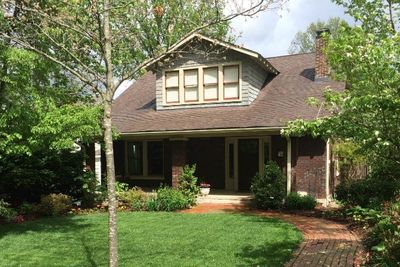David Frederick and Gary Jaeger purchased their home near Belmont in the fall of 2007, but it was early 2008 before they could move in, due to extensive renovations to the property. While it would take a great deal of work to make the house fit their needs, the couple was drawn in by the neighborhood, as well as the house’s architecture.
“First and foremost was the neighborhood,” said Frederick. “This area is so eclectic, and there is so much diversity in the area, it just seemed like this was the perfect neighborhood for us.” The location was also very conveniently located, being just minutes from Jaeger’s Vanderbilt office.
The house itself was also just the style Frederick was looking for. “I’ve always wanted a bungalow, with a great big porch and big columns,” Frederick explained. “Our house was built in the 1930s, and it just had that classic bungalow feel. Unlike a lot of houses in the area, although it looks to be one story, it actually has a full upstairs. Many other houses lose a lot of space from the sloping ceilings.”
Originally the house was about 2,000 square feet, but the couple expanded it to 3,100. “We added a great room and a master bedroom,” Frederick said, “and a big portion of the downstairs was repurposed for a large bathroom and walk-in closet. The other thing we really like is the wonderful screen porch we have. It sits at the tree line, up in the foliage, so it’s like sitting in treehouse – we do love the porch.” Michael Ward was the project’s architect, and Young Builders executed the design.
Frederick and Jaeger’s home is within an historic overlay, which was put in place to protect the look and feel of the neighborhood in the face of increasing redevelopment. “We had to get a variance from the city to do the work we did because of some of the specifics of Michael’s design, but we definitely kept the original feel of the home. From the street it’s a rather unassuming bungalow, but it goes way back—that’s how we gained all the space.”
Frederick and Jaeger have developed their house into a home for themselves and their two Cavalier King Charles Spaniels, as well as a comfortable location for entertaining. “We’ve hosted fundraisers and other events, including a Victory Fund event here in the past,” Frederick said, “as well as political fundraisers. Gary has hosted Vanderbilt functions in the house.
Since Frederick and Jaeger moved in, there has been a lot of development in their neighborhood, but the historic overlay has mostly protected the area immediately around their home from being recreated. “On our street, and streets like it, people buy smaller homes and put on additions that make ours look small by comparison,” Frederick said. “The ones that are in the historic overlay, they have oversight.”
“The ones outside are still mostly keeping to the style of the neighborhood, with the exception of the scale,” he added. “They are classic homes and work with the look of the neighborhood, but the lots are small and the houses are huge. It’s really kind of crazy: just a few houses down on the block that’s not protected they tore down three houses just to build one!”
The last decade has seen amazing advances for the LGBT community, though much remains to be done to secure the rights of the most vulnerable. And while the Supreme Court’s decision in Obergefell v. Hodges is no cure-all, it has done a great deal to cement the process of normalization that particularly gay and lesbians have enjoyed. In short, it is becoming much easier for LGBT people to make themselves at home in the wider culture, even in Middle Tennessee.
Part of that process is actually making homes for ourselves in the region—joining with the larger community in which we live and settling in amongst our neighbors. This isn’t just to keep up with the straight Jones’ and to show that we are as normal as everyone else. Aside from community centers and bars, LGBT homes are centers of communal existence, places of refuge for our friend groups to gather and our children to congregate.
So much community organizing and political action began in the kitchens and dining rooms of LGBT homes in middle Tennessee. Pride events were organized, funds were raised for CARES and other organizations, and life-long friendships were cemented in these harbors. As we move forward into the twenty-first century, the necessity of the home space for these functions may be diminishing, but the LGBT home still serves many purposes.
